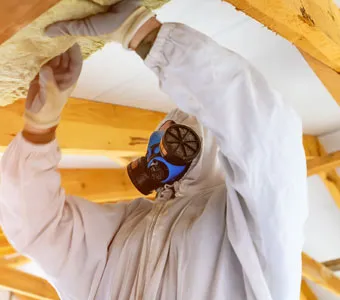What Does Asbestos Look Like and How to Identify It?
Most Americans are aware of the dangers of asbestos and the serious medical issues this substance can cause. However, many people encounter it without realizing it, and they may wonder, “What does asbestos look like, and how to identify it?” The reality is that the raw substance is rarely encountered on its own, and it is impossible to determine if a substance is contaminated by visual inspection alone.
Identifying Different Types of Asbestos
Asbestos is a naturally occurring mineral found in two main forms. Serpentine asbestos fibers are long, curly, and flexible, and the vast majority of global asbestos mining yields this form of asbestos. The most commonly recognized form of serpentine asbestos is chrysotile. The other form is amphibole asbestos, which is straight and shorter than serpentine asbestos fibers. This form is also more dangerous because the fibers can embed deeper inside body tissues.
Amphibole asbestos is found in several varieties, including crocidolite, tremolite, actinolite, anthophyllite, and amosite. While chrysolite asbestos typically appears in fluffy white clumps of fibers, the various forms of amphibole asbestos can be various colors, from white to dark gray, as well as various greens, yellows, browns, and blues. The average person cannot detect asbestos by color, shape, or smell; the only way to identify asbestos is with chemical testing.
The only people likely to encounter asbestos in its raw form are those working in the mining industry. While asbestos mining operations continue globally, they are very carefully controlled and regulated to minimize health risks to workers. It is also possible for mining operations to disturb natural asbestos deposits, creating a very serious health risk for everyone in the vicinity.
Where Can Asbestos Be Found Today?
While it is impossible to discern raw asbestos with the naked eye or determine if a particular substance has been contaminated with asbestos without chemical testing, there are many places today where one might encounter asbestos in various finished products. For decades throughout the United States, asbestos was a commonly used construction material due to its insulating and fireproofing qualities.
Building materials made with asbestos are typically marked clearly, but much of this material has been removed from all types of buildings over the last several decades. However, it is still possible to encounter asbestos materials in older commercial and some residential buildings, usually those built prior to 1980. It is also possible to encounter asbestos in certain types of products made with talcum powder.
Many companies produced hygiene products like baby powder and body powder made with talcum powder, a refined form of naturally occurring talc. While this mineral is safe on its own, it is commonly contaminated by trace amounts of asbestos that can be very difficult to detect. This caused many companies to manufacture consumer products that posed a significant risk of causing mesothelioma due to talc contaminated with asbestos.
Today, most of the companies that previously used talc in their products have switched to alternative ingredients to entirely avoid the risk of asbestos contamination. However, those who continue to use talcum powder invest in extensive chemical testing to ensure their talc is safe. It is important to remember that some of these tests are not foolproof, so it is possible for very small amounts of asbestos to escape detection.
Asbestos FAQs
Q: How Can I Tell if Something Is Asbestos?
A: The only way to tell if something is asbestos is to have the substance chemically tested at an appropriate testing facility. Products made with asbestos usually include clear warning signs, and the use of these products is heavily regulated and controlled. However, it is impossible to detect the raw substance itself without chemical testing. It is possible for trace amounts of asbestos to contaminate other substances, such as talc used to create talcum powder.
Q: How Does Asbestos Cause Mesothelioma?
A: Asbestos causes mesothelioma when asbestos fibers enter the body, typically through ingestion or inhalation. Once these fibers enter the body they can embed in various tissues where they will gradually cause mesothelioma to develop over time. This disease has a very long latency period, sometimes multiple decades, but repeated exposure and exposure to certain types of asbestos can significantly increase the speed at which mesothelioma develops.
Q: What Are the Early Symptoms and Signs of Mesothelioma?
A: The early symptoms and signs of mesothelioma often mimic the appearance of other, less serious diseases. Mesothelioma in the lungs can cause coughing fits, shortness of breath, chest pain, and various forms of respiratory distress. One of the most troubling aspects of this disease is that by the time noticeable symptoms appear, the mesothelioma has already progressed to a critical state, and at this point, the victim can only hope to manage their symptoms.
Q: Do Companies Still Make Products Using Asbestos?
A: Some companies still make products using asbestos, but not nearly to the same scale as in previous years. Additionally, asbestos product manufacturing is highly regulated and subject to extremely strict safety rules. Some companies continue to make products with talc, which can be contaminated with asbestos. However, these companies invest in robust chemical testing to ensure the talc they use has not been contaminated.
Q: How Much Asbestos Exposure Causes Mesothelioma?
A: There is no safe level of asbestos exposure; a single exposure is enough to cause mesothelioma to develop. Various other factors can also influence whether a person will develop this disease and the speed at which it develops, such as age, medical history, patterns of exposure, and the type of asbestos they have encountered. Ultimately, just a single exposure to asbestos could potentially cause mesothelioma that will not appear noticeably for many years.
Wallace & Graham, P.A., has successfully helped many past clients navigate complex mesothelioma cases, and we are ready to put this experience to work for you. If you believe you have been exposed to asbestos, or if you or a loved one has been diagnosed with mesothelioma, trust our team to help you determine your most viable legal options in this difficult situation. Contact us today and schedule a free consultation with our team to learn more.






